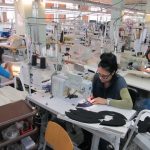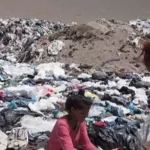 It should be possible to make the textile industry a waste-free sector because theoretically 97% of textile waste can be recycled. But in actual practice the process of textile recycling is quite complicated in terms of its availability, consistency of waste supply and the current uncertainty of ready market for recycled materials. Generally, apparel cuttings waste available with the manufacturers is new and clean and may be processed for recycling without any special treatments thereby which makes recycling quite feasible economically. The foremost step in the entire recycling process is the waste collection and it’s sorting according to color and fiber content.
It should be possible to make the textile industry a waste-free sector because theoretically 97% of textile waste can be recycled. But in actual practice the process of textile recycling is quite complicated in terms of its availability, consistency of waste supply and the current uncertainty of ready market for recycled materials. Generally, apparel cuttings waste available with the manufacturers is new and clean and may be processed for recycling without any special treatments thereby which makes recycling quite feasible economically. The foremost step in the entire recycling process is the waste collection and it’s sorting according to color and fiber content.
It is unrealistic to expect large textile and apparel companies that generate waste to have their own in-house recycling facility because of several practical and economic reasons. Tons of old clothes end up in landfill every day. The volume of clothing waste is rapidly growing due to increasing textile consumption and the fact that half of the textile products purchased by consumers are discarded as waste. This provides a business opportunity for setting up of dedicated recycling plants.
In Europe, the total textile waste is estimated to be more than 28kg/capita. About half (53 %) of the textile waste there is sent to landfill or waste incineration, quart (24 %) of it goes to unknown treatment or storage and the rest is either exported for reuse (17 %), reused in the origin country (4 %) or sent to material recycling (2 %). Compared with most other waste materials the material recycling is very low for textile waste while reuse is higher than for most other kinds of waste materials.
The recycling activities in Europe and the US are being undertaken on a large scale due to increasing awareness of the environmental issues and also due to strict government legislation with regard to waste handling. Large recycling companies are doing roaring business. They are working out newer ways to boost the waste collection and are installing automatic machinery for waste material handling, sorting, treatment, recycling and reuse. There is also a huge global market for used clothing – both unsorted and sorted – especially in LDCs and less developed countries. A significant amount of the clothes collected is sold in these markets, either as unsorted to other sorting plants or sorted for sale in second hand market etc.
Large amounts of water are used production of natural fabrics like cotton whereas the production of synthetic fiber/fabrics consumes large amounts of energy. The life cycle of textiles, therefore, leads to huge greenhouse gas emissions from energy use and CO2, CH4 and N2O from cotton production. The hazards are caused by the use of pesticides and chemicals in the manufacture of fiber raw materials and textile production. The benefits of recycling and reusing the raw materials thus produced are immense. It is estimated that recycling provides a reduction of between -1200 and -1800 kg CO2 equivalents per ton of textile waste. Since textiles are treated by a variety of chemicals during production to achieve special properties, there may be residual harmful chemicals such as dyes, heavy metals and organic contaminants that can get into the environment. There are also controversies regarding the chemicals and technologies used during textile manufacturing. For example, growing genetically modified cotton and using nanotechnology involve hazardous materials that can affect both health and environment.
The recycling of textile waste, therefore, becomes not only more urgent but also more technologically advanced and capital intensive requiring huge capital investment for building large modern recycling plants. The opportunities do exist but they require very thorough investigation, study and clear direction.





